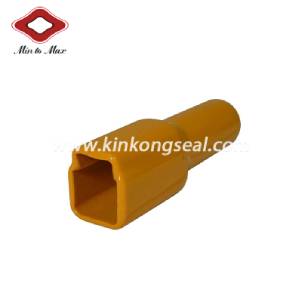Jun. 15, 2020

Silicone Single Wire Seal manufacturer shares this article for you.
In the rubber industrial products, custom rubber components are a type of basic accessories with very high technical content and multiple categories. Although it is installed in an inconspicuous sealing device, it lies in the game between the silent place and the leak, which is related to the role of life and death. In the process of mankind's continuous pursuit of scientific progress and innovation, preventing "three leaks" (oil, water, gas) is the key to success. Sealing devices are everywhere in the sky, on the ground, in the ocean, and especially in the development of the space field. Sealing engineering is the most critical high-tech. It is the product of multidisciplinary intersections. Therefore, the sealing technology should be at the forefront of other projects to "escort" security in various fields. "Guarantee will not leak" will be the eternal theme of the present and future.
At present, all kinds of seals with different shapes and specifications are produced from polymer materials. Synthetic rubber is still the main reason, because most of the working conditions that require sealing, most of them work in harsh and harsh environments, such as oil resistance. Chemical medium corrosion resistance, high-temperature resistance, low-temperature resistance, weather resistance, harmful gas resistance, etc., must be based on different working conditions, targeted selection of different characteristics of synthetic rubber, such as nitrile rubber, EPDM rubber, fluorine rubber, acrylic Ester rubber, silicone rubber, and various thermoplastic elastomer materials that can meet the conditions of use. From the perspective of performance requirements and cost, the most widely used synthetic rubbers for seals are nitrile rubber, EPDM rubber, silicone rubber, fluorine rubber, and acrylic rubber.
1. Nitrile rubber series (NBR)
Because the variety of nitrile rubber is complete and the process is mature. It is made by copolymerization of butadiene and acrylonitrile. Because of its polar nitrile group, it has excellent oil resistance (second only to fluorine rubber), heat resistance up to 130 degrees Celsius, good comprehensive physical properties such as wear resistance, airtightness, and corrosion resistance, making it an oil-resistant seal. Popularize rubber. At the same time, according to the content of acrylonitrile, its varieties characterize the degree of non-polar oil resistance. Internationally classified, there are low acrylonitrile-butadiene rubber, (acrylonitrile content below 24%) medium acrylonitrile-butadiene rubber (acrylonitrile content 25% to 30%) and medium and high acrylonitrile-butadiene rubber. (Acrylonitrile content 31% to 35%), high acrylonitrile content (acrylonitrile content 36% to 42%), and very high acrylonitrile rubber (acrylonitrile content above 43%). The acrylonitrile content of our domestic nitrile rubber is generally divided into high, medium, and low grades. Technicians can comprehensively consider its non-crystalline, unsaturated, narrow molecular weight, and oil resistance, but also take into account other physical properties, especially low-temperature resistance, to select the appropriate grade of rubber to design the vulcanization system. Nitrile rubber is widely used in the field of sealing. Commonly used to produce various oil seals, various O-rings, gaskets and diaphragms, valves, etc.
In the nitrile rubber series, there is another outstanding leader, that is, the hydrogenated nitrile rubber that few manufacturers in the world can produce. Don't underestimate the prefix "hydrogenation", it has a highly saturated main chain, butadiene segment is replaced by polyethylene segment structure, so there is a tendency to crystallinity, the allyl hydrogen atoms are greatly reduced, making The thermal stability of hydrogenated nitrile rubber is significantly enhanced. The higher the degree of hydrogenation, the greater the resistance to ozone and the chemical media. But it must be pointed out that in terms of formulation design technology, it is not the ideal with the highest degree of hydrogenation, because it involves the elasticity and vulcanization crosslink density of hydrogenated nitrile rubber. The performance of hydrogenated nitrile rubber is mainly analyzed from the molecular weight, combined with acrylonitrile content and hydrogenation degree. Hydrogenated nitrile rubber gives new and excellent properties due to hydrogenation saturation. In maintaining the nitrile rubber gene, it adds higher heat resistance and excellent physical and mechanical properties. It is also resistant to various industrial oils, fluids containing additives, and fuel oils. Under harsh working conditions, it can still show good resistance to flexure and wear.
Because hydrogenated nitrile has the above-mentioned high-temperature resistance, oil resistance, and excellent physical and mechanical properties, its application is very wide, the harsh working conditions of deep good mining in the oil field, its rubber accessories are non-hydrogenated nitrile rubber, such as oil field mechanical equipment seals With various types of O-rings, packer rubber cylinders, screw pump stators, blowout preventer accessories, compression bladders for drilling machines, etc., the author once went to Karamay oil field to develop hydrogenated nitrile rubber accessories for oil wells, changing the pattern of dependence on imports.
Tel: +86 13705057546
E-mail: info@kinkong.com
Add: #27 Hengjing Xiyi Road, Liushi Town, Yueqing City, Zhejiang Province, 325604, China.
Copyright © Min To Max All Rights Reserved |